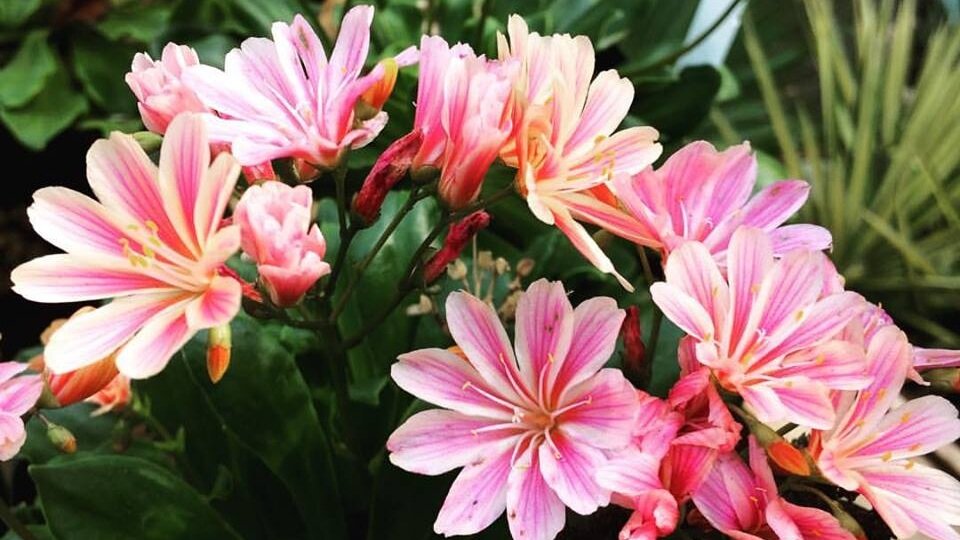
Care for Your Bamboo Palm
Palms give a wonderful tropical feeling to the indoor garden. They are bold houseplants that command attention without needing the attention of care.
Ease of care: Easy!
Water: Watering thoroughly, keeping the soil moist during the growing season (May-October). Water less frequently during the winter.
Light: Bright indirect light. Can tolerate morning/eastern direct light.
Propagation: Remove side shoots with roots and re-pot in regular potting mix. Keep soil moist.
Growth Habit/Height: Tall plants (about 6 feet in maturity) form clumps of stems with long, arching leaves. Individual leaflets are short, broad and curving. This palm has a narrow growth habit that is appropriate for most homes.
Soil: Regular potting mix.
Repotting: Every 1 or 2 years. Many palms have fragile root systems and can be easily damaged, so care should be taken when re-potting the plant.
Toxicity to animals: Not toxic. Katie’s cat Mango approves!
Fertilizing: Fertilize during the growing season, every two months. Use a slow-release palm fertilizer with an analysis like 12-4-12 or 8-2-12.
Does a Bamboo Palm sound like a great plant for your home? Click here to see if we have any in stock!
Breaking Down Fall Composting
Fall is a great time for composting. Not only for building your own bin with colorful fallen leaves, but also for top dressing your garden! Spreading compost over a garden bed, then covering it with mulch will encourage growth of soil organisms that will be super beneficial come springtime!
Break-down of Benefits:
• Encourages the growth of earthworms and other macro-organisms, whose tunneling makes room for water and air, making way for optimum root growth
• Provides nitrogen, phosphorus, potassium, sulfur and micro-organisms that are essential for plant growth • Acts as a glue, holding water and soil particles together, and makes soil resistant to erosion
• Binds itself to polluting metals, pesticides and other contaminants to prevent them from washing into waterways or being absorbed by plants
• Suppresses soil-borne diseases and plant pathogens (a number of plant and lawn diseases are suppressed by micro-organisms found in compost!)
Practice a technique called "side dressing". Apply a layer of compost a few inches away from the plants, protecting delicate plant stems from active microorganisms. This way, the compost is applied as a mulch and it reaps multiple rewards!
Seacoast Compost
Made in Oregon, certified organic and biodynamic. They make use of “waste” from three major Oregon Coast Industries. Fish, shrimp and crab from seafood processing, along with cow manure and bedding from organic dairies, as well as Red Alder hardwood from the lumber industry. They add in some homeopathic preparations like yarrow, chamomile, nettle, oak bark, dandelion and valerian to enliven the whole mix and stimulate plants to reach their full potential in their environments.
Malibu Compost
Made in California, certified organic and biodynamic. Their farm-made compost combines organic dairy cow manure, straw, wood chips, and biodynamic concentrations of yarrow, chamomile, valerian, stinging nettle, dandelion and oak bark. They proudly do not use products with synthetics, greenwaste, pesticides, hericides, growth hormones, and sewage sludge.
Sources:
King County Composting
SeaCoast Compost
Malibu Compost
A Trove of Cloves!
In addition to garlic being mighty yummy and great for our immune system, it is also a wonderful pest (and vampire) deterrent. Adding garlic around your garden and in different beds will be super handy when it comes to the amount of pests you have to manage come Spring and Summer.
Planting Instructions:
Break bulbs into individual cloves right before planting. Leave the papery skin on.
Plant 6-8" apart and 3-4" deep in well drained soil.
Water gently to settle the soil
Mulch the bed well with 3-6 inches of weed-free straw, hay or cut grass (this will also assist in easier harvesting in the Summer and deterring critters such as squirrels). Even as air temperatures drop, the soil will stay warm enough for the newly planted cloves to establish roots before the ground freezes.
Tips from Great Northern Garlic
Sometimes you'll see some green shoots form in fall; that's fine and won't harm plants. They'll begin growing in earnest in spring. If your soil needs a boost, add organic compost or all purpose fertilizer before planting.
You can soak the garlic cloves in a fish emulsion or liquid kelp fertilizer overnight before planting to improve health of the cloves. Fertilize again in the Spring. Harvest in early summer, generally around the 4th of July, or depending on when half of the leaves have died.
Harvesting
Each leaf above ground indicates a layer of protective paper wrapped around the bulb. A reliable harvest indicator is when half the leaves have died off, and half are still green. The leaves start to die off from the bottom up.
Stop watering 2 weeks prior to harvest and do not wash your garlic or remove the bulb wrappers after harvesting.
Storing
To store garlic, the process is calling curing. Leave the stalks and roots on the bulbs and either bundle 8 to 10 garlic stems together, tie with twine, and hang bulb-side down in a cool, dark space, like a basement, or lay the garlic flat on a raised screen in a single layer. Allow the bulbs to cure for three to four weeks.
Varieties Available at Urban Earth:
Striped violet wrappers house purple tinged cloves that explode with a fiery flavor that mellows out nicely to a rich garlic aftertaste. Stores well. Approx. 7-10 cloves per bulb and approximately 7-8 bulbs = 1 pound. Planting 1 pound will yield about 4-7 pounds.
Russian Red garlic has big bulbs that have a slightly purple skin that wraps the bulbs and cloves. This variety is a great garlic to grow for soil conditions that are slightly damp. Russian Red is one of the most flavorful heirloom garlic varieties. Approximately 6-9 cloves per bulb and approx. 7-8 bulbs = 1 pound. Planting 1 pound will yield about 4-7 pounds.
Great for culinary use and is an early season garlic harvest! This variety is one of the most commonly grown varieties in the U.S., and for good reason. It is a medium, easy to grow softneck, with a nice mild flavor and excellent storage ability. Approximately 8-12 cloves per bulb.and approx. 6-7 bulbs = 1 pound. Planting 1 pound will yield about 6-10 pounds.
Large cloves streaked with hues of rose, this beautiful Silverskin variety has a robust flavor. Great for cooking and long storing, up to 12 months! Excellent for braiding. Approximately 10-20 cloves per bulb and approx. 5-6 bulbs = 1 pound. Planting 1 pound will yield about 6-10 pounds.
All of our garlic is Certified Organic and Grown in Oroville, WA.
Water Wisely
July flew by in a beautiful buzz, and August is coming in hot (quite literally). With warmer temperatures and longer sun exposure, your plants are thirsty! Now is the time to introduce water wise techniques in your urban slice of earth.
Water is a precious resource and absolutely vital for keeping your vegetable garden happy. Wise watering techniques conserve water, save money, produce bigger yields and promote healthy plant growth. Here are five general guidelines to keep your garden thriving during these warmer months:
Healthy Soil: Establish retentive soil that slowly releases water to the plants. A top layer of mulch will also reduce the amount of water and weeding needed.
Timing: Water before 10AM. This will lead to less evaporation and more water absorbed by the plants. Leafy greens love an evening watering to cool down their soil and prevent plants from bolting.
Water Slowly: Water slowly, deeply, and less frequently. This allows plants to develop large root systems. Focus your watering into the soil, not onto the plant.
Be Consistent: Group plants by their watering needs. This is a great way to make watering easier from the get-go. Each vegetable or annual flower plant should receive about 1-2 gallons of water per week, spreading it out so you water the same amount every couple of days.
Equipment: A leaky hose is the quickest way to waste water. Be sure your hoses and faucet are in good working order. Simple dial timers and drip irrigation are great for very direct and accurate watering. Rain barrels are also a great way to water the natural way.
Next, we’ll talk about Xeriscaping! This is the use of drought tolerant, often native plants in your landscape. (Don’t picture a desert, we promise there are colors and flowers involved!)
Links:
The Seattle Conservation Corps Rain Barrels and Supplies for Sale
Tilth Garden Alliance
Photo by Randy Fath on Unsplash










